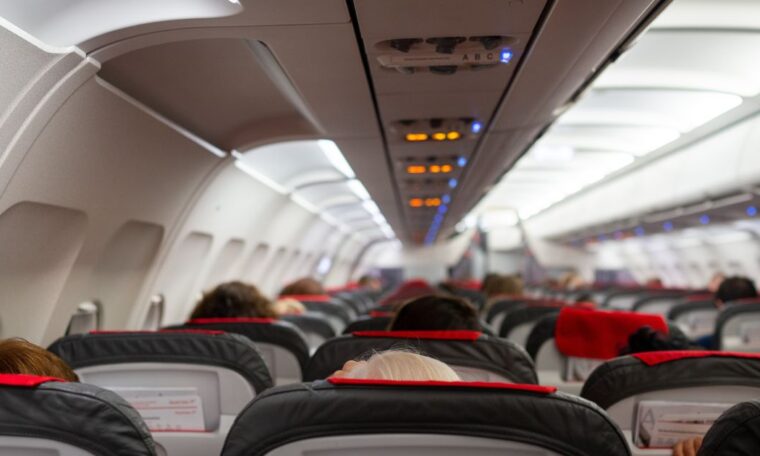
“Is there a doctor on board?”
Those who fly frequently may have heard this question asked at some point on a plane. In-flight medical incidents can range from minor to serious, and sometimes the outcome is fatal.
In February, a 41-year-old passenger died after falling ill on an American Airlines flight from the Dominican Republic to North Carolina. Weeks earlier, a 63-year-old experienced a medical emergency and died on a Lufthansa flight from Thailand to Germany. And just this week, a 73-year-old passenger died aboard a Singapore Airlines flight after the plane hit severe turbulence.
“A death on board at 35,000 feet is one of the most feared situations for flight attendants, often because it follows a medical emergency, which is already very stressful to manage,” said Jay Robert, a former flight attendant and the founder of the brand A Fly Guy. “When a medical emergency results in death, it can be a very traumatic experience for everyone on board, especially if the passenger is young.”
Although these incidents receive much media coverage, in-flight deaths remain relatively rare. A 2013 study published in the New England Journal of Medicine found that over a period of about three years, there was 1 in-flight medical emergency for every 604 flights, and of the 10,914 afflicted passengers for whom there was follow-up data, 0.3% died. That translates to 36 known deaths in that period, or about one per month, with 30 of those deaths occurring during flight.
“The likelihood of facing a death in the sky increases for crew members working on wide-body aircraft on long-haul routes,” Robert said. “There are more passengers, fewer opportunities to divert, and passengers are in a pressurized environment, sitting for extended periods, which often can lead to serious health problems.”
So what happens when one of these problems arises and a passenger dies during a commercial flight? Below, Robert and other experts explain the procedures that crew members must follow to handle the situation with sensitivity and professionalism.
The crew must follow emergency medical procedures.
“Airlines typically develop their procedures in compliance with international aviation regulations and guidelines,” Dr. Paulo Alves, the global medical director of aviation health at MedAire, told HuffPost. He named the International Civil Aviation Organization and the International Air Transport Association, or IATA, as two authorities that issue such guidance.
“These guidelines provide a framework, but airlines tailor their procedures to fit their specific operational needs and training programs,” Alves said.
Although the exact protocols vary from airline to airline, flight crews are typically trained to provide basic life support, notify the pilots and seek assistance from medical professionals.
“We have AEDs [automated external defibrillators] on board the planes to use if a passenger goes unconscious and stops breathing, and we’re all trained to do CPR,” said Heather Poole, a flight attendant and the author of “Cruising Attitude: Tales of Crashpads, Crew Drama, and Crazy Passengers at 35,000 Feet.”
“We’ll page for a medical professional to help us if we need them,” she said. “And if there’s not one on board, we can contact a physician on the ground.”
Airlines use services like MedAire’s MedLink to get guidance from on-call medical professionals during emergencies. IATA guidelines recommend that the crew and any medical professionals on board administer CPR until it becomes unsafe due to turbulence or landing conditions, the passenger has been transferred into the care of emergency services, or the person is believed to be deceased.
“Crew members cannot declare if a person has died or not,” Alves said. “But if specific criteria are met ― e.g., the person is not responding and not breathing, CPR has been performed for 30 or more minutes, and AED is used without return of spontaneous circulation ― the person could be presumed dead.”
He noted that a medical volunteer on board might also come forward to provide assistance and, in some cases, determine whether a passenger has died.
If a passenger is presumed dead, there are best practices for handling them with respect.
When a medical emergency arises, the crew must notify the captain, who will decide with the airline’s operations center whether to continue to the intended destination or divert to another airport. There are several logistical and humanitarian aspects to weigh during this process.
“A death on board does not automatically entail a diversion to another airport,” said Markus Ruediger, the assistant director of corporate communications at IATA. “Diversion to a third country ― neither origin nor destination of the flight ― could add further complexities in repatriating the deceased. Furthermore, airlines are required to inform the relevant authorities of the death on board.”
There are specific procedures for securing the deceased person’s body in a way that respects their dignity and shows sensitivity to their travel companions and others on the plane.
“To handle the body with dignity and respect while ensuring minimal disruption to other passengers, the crew covers the deceased passenger with a blanket,” Alves said. “Nearby passengers may be moved to other seats if space permits. The body may be moved to a less populated area, such as an empty row, if available. Otherwise, the body is secured in the original seat with the seatbelt fastened to prevent movement during the flight.”
He added that the crew wears personal protective equipment to maintain hygiene and safety while handling the body.
Protocols might be different for lengthier flights with many more hours remaining. When Robert worked for a major international airline that operated some of the world’s longest flights, the on-board equipment included a kit with a body bag and toe tags.
“If the pilots decided to continue to our destination, we would have to prepare the body for storage,” he recalled. “This involved moving the deceased to a private area where the body could be stored flat for the remainder of the journey without other passengers noticing and without obstructing an exit. It was essential to keep the body flat, as postmortem stiffening of muscles would start about two hours after death and the flights could still have a long way to go.”
The aircraft that Robert worked on typically had first-class suites with flat beds and privacy doors, which crew members would use if one was vacant.
“We were trained to use the onboard wheelchair, which we discreetly wheeled backward through the cabin to move the body to a suitable location,” Robert said. “Once the body was in the body bag, we were trained to zip it only to the neck, as the person wouldn’t be officially declared dead until after the plane landed. We could use a blanket to cover the head out of respect.”
For the remainder of the flight, the crew must prepare for what will happen to the body after landing.
“Throughout this process, the crew communicates with ground staff at the destination airport to ensure proper handling upon arrival,” Alves noted.
When a plane makes an emergency landing due to a medical situation, passengers are advised to remain seated until health professionals board and remove the affected individuals. But the IATA recommends the opposite if the passenger is presumed dead.
“Disembark other passengers first and make sure the family members stay with the body,” its guidelines note. “Do not disembark the body until the proper local authority has arrived to take care of the body and that the ground personnel is available to assist the family members.”
It’s important to acknowledge the trauma and emotion of the situation.
While flight attendants receive training in basic life support and how to recognize and respond to various medical conditions, they also learn the best ways to offer emotional support during these traumatic situations.
“A significant part of our training on death on board was how to break the news to the people traveling with the deceased,” Robert recalled. “We had scripts to follow loosely, and we role-played how to tell someone their travel partner had died. A lot of care goes into this process.”
Flight attendants handle the deceased person’s body with awareness of how distressing the situation is for not just their loved ones, but for onlookers as well. They are prepared to talk to and comfort any passengers who may be experiencing emotional difficulty.
“A medical emergency is very stressful on crew,” Poole said. “On my last flight from London to New York, a passenger had a seizure during the middle of the dinner service. One minute we were serving meals, and the next minute we were running for oxygen and paging for a doctor. Twenty minutes later, we were back to serving drinks and picking up trash. It can be very overwhelming at times.”
Passengers should understand that a medical emergency becomes crew members’ top priority, so service often stops.
“I have literally been on the floor trying to keep a passenger alive while other passengers tapped me on the shoulder, asking for drinks,” Robert said. “Additionally, please keep your phones away during these sensitive times. Not everything needs to be filmed and posted on social media. Someone traveling with a person who dies in flight doesn’t need to have the nightmare relived online.”
Flight attendants do not need to relive the nightmare either.
“We have resources available to us after an emergency situation that helps crew deal with the emotional stress,” Poole noted.
Airlines can provide mental health resources like counseling and peer support through MedAire and similar companies.
“It’s essential to acknowledge the professionalism and compassion of flight crews in these challenging situations,” Alves said.
Our 2024 Coverage Needs YouIt’s Another Trump-Biden Showdown — And We Need Your HelpThe Future Of Democracy Is At StakeOur 2024 Coverage Needs YouYour Loyalty Means The World To Us
As Americans head to the polls in 2024, the very future of our country is at stake. At HuffPost, we believe that a free press is critical to creating well-informed voters. That’s why our journalism is free for everyone, even though other newsrooms retreat behind expensive paywalls.
Our journalists will continue to cover the twists and turns during this historic presidential election. With your help, we’ll bring you hard-hitting investigations, well-researched analysis and timely takes you can’t find elsewhere. Reporting in this current political climate is a responsibility we do not take lightly, and we thank you for your support.
Contribute as little as $2 to keep our news free for all.
The 2024 election is heating up, and women’s rights, health care, voting rights, and the very future of democracy are all at stake. Donald Trump will face Joe Biden in the most consequential vote of our time. And HuffPost will be there, covering every twist and turn. America’s future hangs in the balance. Would you consider contributing to support our journalism and keep it free for all during this critical season?
HuffPost believes news should be accessible to everyone, regardless of their ability to pay for it. We rely on readers like you to help fund our work. Any contribution you can make — even as little as $2 — goes directly toward supporting the impactful journalism that we will continue to produce this year. Thank you for being part of our story.
It’s official: Donald Trump will face Joe Biden this fall in the presidential election. As we face the most consequential presidential election of our time, HuffPost is committed to bringing you up-to-date, accurate news about the 2024 race. While other outlets have retreated behind paywalls, you can trust our news will stay free.
But we can’t do it without your help. Reader funding is one of the key ways we support our newsroom. Would you consider making a donation to help fund our news during this critical time? Your contributions are vital to supporting a free press.
Contribute as little as $2 to keep our journalism free and accessible to all.
As Americans head to the polls in 2024, the very future of our country is at stake. At HuffPost, we believe that a free press is critical to creating well-informed voters. That’s why our journalism is free for everyone, even though other newsrooms retreat behind expensive paywalls.
Our journalists will continue to cover the twists and turns during this historic presidential election. With your help, we’ll bring you hard-hitting investigations, well-researched analysis and timely takes you can’t find elsewhere. Reporting in this current political climate is a responsibility we do not take lightly, and we thank you for your support.
Contribute as little as $2 to keep our news free for all.
Dear HuffPost Reader
Thank you for your past contribution to HuffPost. We are sincerely grateful for readers like you who help us ensure that we can keep our journalism free for everyone.
The stakes are high this year, and our 2024 coverage could use continued support. Would you consider becoming a regular HuffPost contributor?
Dear HuffPost Reader
Thank you for your past contribution to HuffPost. We are sincerely grateful for readers like you who help us ensure that we can keep our journalism free for everyone.
The stakes are high this year, and our 2024 coverage could use continued support. If circumstances have changed since you last contributed, we hope you’ll consider contributing to HuffPost once more.
Support HuffPost
Already contributed? Log in to hide these messages.
Source link
CHECK OUT: Top Travel Destinations
READ MORE: Travel News



